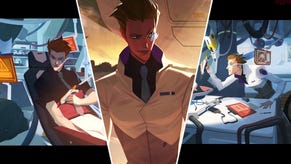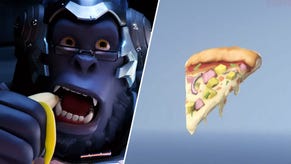Overwatch Retribution Fills in the Gaps in the Game's Lore
The origins of Reaper are imminent.
This article first appeared on USgamer, a partner publication of VG247. Some content, such as this article, has been migrated to VG247 for posterity after USgamer's closure - but it has not been edited or further vetted by the VG247 team.
Despite having an almost two year-long history, the lore of Overwatch has been kept at arm's length from the main game. Players can see character details in brief dialogue between heroes or in sprays, or they can check out the separate comics and cinematic shorts, but they never tell the full story. They only focus on character moments or snippets from the past. They've never delved into the key element of why Overwatch the organization fell and why it's being reassembled in the present-day. For a game that touts its lush backstory, Blizzard has never integrated that into the game itself.
Overwatch Uprising, a limited-time event from April 2017, was the first time that players got to experience a historical mission from Overwatch history first hand. Overwatch Archives: Retribution, this year's April event, tells another. It could've just been another repeat of last year's event—similar to what the studio did with last year’s Winter Wonderland and Summer Games events—but this time, Blizzard wanted to make something special. It wanted to address the story.
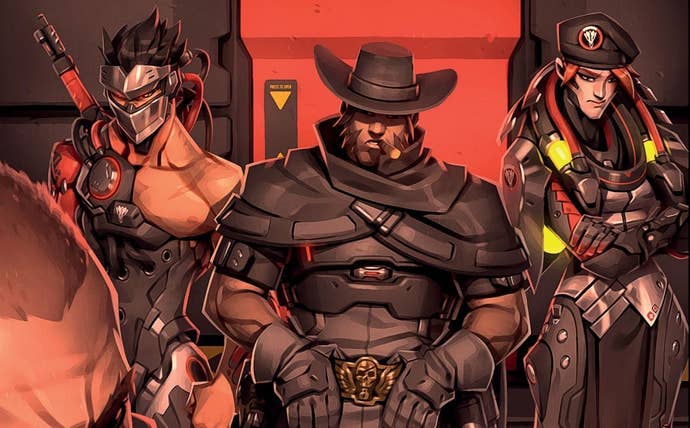
With last year's Uprising event, Blizzard told a simple story about Tracer on her first mission. While it was enlightening to see what Overwatch might've been like while it was still functioning (although barely), there's nothing surprising about Tracer inspiring the older folks on the team with her optimism and joy of helping people. Uprising tells a sweet, nostalgic story and provides a bit more detail into the conflict in London after the Omnic War, but it doesn’t reveal much that we didn’t already know.
But then there's Retribution, which seeks to tackle the backstory Gabriel Reyes, aka Reaper, one of the more mysterious characters in the game. We know that Reyes was once an Overwatch soldier who later joined Blackwatch, a black-ops group within Overwatch. At some point, he becomes Reaper and is now a part of Talon, a terrorist organization that once was Overwatch's main adversary. What caused this massive switch and downfall? That's where Retribution comes in, using the game to show a huge character moment that might otherwise usually be relegated to Blizzard's comics and animated shorts.
Early last week, I spent some time with Retribution at the Blizzard campus before the big launch on April 10. The comic released Wednesday, titled Blackwatch, adds more backstory leading up to Retribution, showing Reyes' first disagreement with Overwatch. After a bombing destroys an Overwatch headquarters in Switzerland, killing dozens and severely injuring his good friend—and Widowmaker's former husband—Gerard, he decides he doesn't want to go "by the book" as Jack Morrison, a.k.a. Soldier 76, wants to do. Everybody knows that Talon is behind it, but Overwatch wants to handle it as peacefully as they can.
Reyes has other plans. At the beginning of Retribution alongside three Blackwatch members—McCree, Moira, and Genji—the foursome heads to Rialto, an area in Venice, Italy, and break into the office of Antonio [last name redacted], a.k.a. Antonio Bartalotti, a.k.a. Antonio Giordani, according to a dossier released by Blizzard. However, instead of extricating him as planned, Reyes kills him, causing Talon agents to descend on the group. The rest of the mission has players mowing down the agents so they can get to an extraction point on the other side of the map.
It's evident immediately that with Retribution, Blizzard wants to streamline what they began with Uprising, creating a PvE mission that had stakes and a place in the established lore, but was also comprehensible to the player. In Uprising, four players were tasked with mowing down an endless stream of robots because… actually I'm not entirely sure.
"We actually felt that Uprising had too many objectives... and the objectives were too heavy and players weren't associating what they were doing with what the objectives were and what the story was," Jeff Kaplan, director of Overwatch, says during a presentation for the new event. "We tried to tone down the amount of objectives in Retribution."
Take, for example, an early task in Uprising where Tracer, Mercy, Torbjorn, and Reinhardt have to hack some consoles. It's obvious the player has to do something with them, and objective markers make them easy to find, but I was shocked to find it was because there were guns on the outside of the building that needed to be disabled. There is no ambiguity in Retribution. You have one singular objective: get out and to the extraction point. Kill Talon operatives along the way and don't die.
Another change from Uprising is how players are given the objectives. During Uprising, you have Soldier 76 and others giving you orders via coms, but in Retribution, you're giving each other updates. There's a woman coordinating the extraction, but most dialogue comes from the other characters. It's a small tweak, but it helps to ground the player in the objective and helps to raise both the physical and emotional stakes of the escape. Everybody's going to make it out alive, but McCree isn't too happy with the way Reyes handled the mission.
Blizzard started work on Retribution last May, almost immediately following Uprising's launch, and the amount of effort shows. There's a new UI, upgraded combat systems, entirely new enemies (way more refreshing than just fighting other characters like in Uprising or the Halloween-themed PvE mode Junkenstein's Revenge), more complex spawning systems, and a new map: Rialto, which is set to debut as a full PvP map several weeks after Retribution launches. There are three special enemies: the Assassin, the Sniper, and the Heavy Assault, which contain pieces from established characters but are completely new to the story. The Assassin stands out, taking some cues from Sombra's kit but moving around and jumping on players like a Witch from Left 4 Dead 2. In terms of spawning systems, enemies no longer just come through doors but can instead drop from the ceiling or from Talon ships.
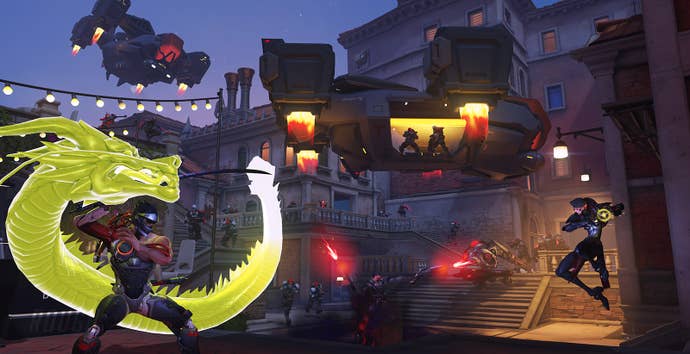
"While we were happy with [Uprising] for our first mission experience, we thought it could be better in a couple different ways," says assistant game director Aaron Keller, echoing Kaplan's comments about confusing objectives, but also noting the improved technology. "We kind of broke our backs at the beginning of last year, of 2017, to get Uprising out the door. So this time we worked on a lot of different spawning systems."
Keller notes that a lot of the systems his team experimented with for Retribution will be able to help out with future PvE and other events in the future.
"The amount of postmortem-ing we did on Uprising was pretty amazing," Kaplan says. "We're very curious about PvE and want to learn how to do it better."
Then there's talk of the Story Mode's lineup. While last year had one person of each class represented, Retribution has three DPS and a healer. Blizzard wondered if it was even possible to do, but didn’t have much of a choice considering who was a part of Blackwatch at the time. It causes players to rethink what they understand about Overwatch strategy, but it’s possible to succeed even on harder difficulties just based on the strengths of the characters. Despite having three characters from the same class, they still manage to be different enough so that players have multiple ways of completing a task. Obviously in All Heroes Mode, available in the Arcade during the event, anything is possible.
It's all in service of telling one of the most important stories in current Overwatch canon. We don’t know how Gabriel Reyes became Reaper, and Retribution will be the beginning of Blizzard telling that story.
"It's also the start of a very big story arc for the history of Overwatch in general. Reyes turning into Reaper and the fall of Overwatch are all one big interconnected story and this is the start of us telling that to the player,” Keller explains. "It was something we thought was important to start putting out there."


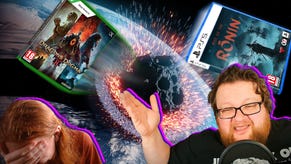
.jpg?width=291&height=164&fit=crop&quality=80&format=jpg&auto=webp)
